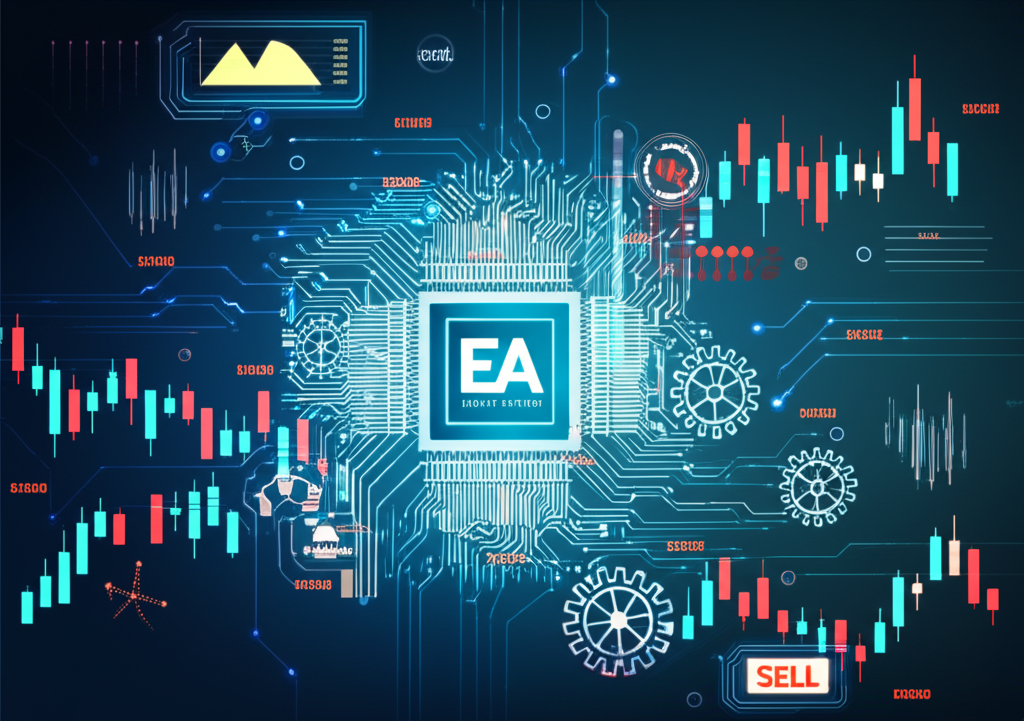Introduction to Expert Advisors (EAs) on MT4

In the world of online forex trading, MetaTrader 4 (MT4) remains one of the most widely adopted platforms, thanks in large part to its support for automated trading through Expert Advisors (EAs). These are software programs designed to operate directly within the MT4 environment, carrying out trading decisions without the need for constant human oversight. By encoding a set of predefined rules into code, EAs can scan market conditions, identify opportunities, and place trades automatically—offering traders a powerful tool to stay active in the market at all hours. As financial markets grow more dynamic and data-intensive, the appeal of algorithmic trading has surged, with EAs leading the charge for both retail and institutional participants.
How Expert Advisors Work: The Mechanics Behind Automated Trading

At the heart of every Expert Advisor lies a set of logical instructions written in MetaQuotes Language 4 (MQL4). These rules define how the EA interprets market behavior—using inputs like price action, moving averages, RSI levels, or other technical indicators—to make trading decisions. When the specified conditions are met—such as a stochastic crossover or a breakout beyond a key resistance level—the EA generates a signal and immediately executes a trade. This entire process happens in real time, with the program continuously monitoring incoming price ticks through the OnTick() function. Once triggered, the EA can open, modify, or close positions based on its internal logic, ensuring that every action aligns precisely with the strategy it was built to follow.
The Advantages of Using Expert Advisors in MT4

Automated trading systems have transformed how individuals approach the forex market, and Expert Advisors stand at the forefront of this shift. Their ability to function without fatigue, bias, or hesitation gives them a distinct edge over manual trading—especially in volatile or fast-moving environments.
24/7 Trading Capability
Financial markets operate around the clock, spanning multiple time zones from Sydney to New York. A human trader simply can’t monitor charts continuously, but an EA can. Once activated, it remains vigilant across all market sessions, capturing opportunities that may arise during off-hours or major news releases. This constant presence ensures that strategies aren’t interrupted by sleep, work, or personal commitments, making EAs ideal for traders who want consistent market exposure.
Elimination of Emotional Trading
One of the biggest challenges in trading is managing emotions. Fear can cause traders to exit winning positions too early, while greed might lead to holding losing trades in hopes of a turnaround. EAs remove this psychological burden entirely. Since they follow a fixed set of rules, they execute trades with mechanical precision—whether the market is surging or collapsing. This emotional neutrality often leads to more disciplined outcomes, particularly during periods of high volatility when human judgment tends to falter.
Backtesting and Optimization
Before risking real capital, traders can test an EA’s performance using historical market data—a process known as backtesting. MT4’s Strategy Tester allows users to simulate how the EA would have performed over past price movements, providing insights into profitability, drawdown, win rate, and trade frequency. Beyond simple testing, optimization tools let users fine-tune parameters like lot size, stop-loss levels, or indicator thresholds to improve results. However, this power comes with a caveat: over-optimization can lead to misleading outcomes, which we’ll explore later.
Speed and Efficiency
Markets move quickly, and even a delay of a few seconds can mean the difference between profit and loss. EAs process incoming data and execute orders almost instantaneously, far outpacing human reaction times. This speed is especially valuable in scalping or high-frequency strategies where small price fluctuations are exploited. Additionally, faster execution reduces slippage—the gap between expected and actual fill prices—leading to better overall trade performance.
Diversification of Strategies
An experienced trader might struggle to manage more than a few currency pairs at once, but an EA can handle multiple instruments simultaneously. Whether running the same strategy across different assets or employing varied approaches on a single account, EAs enable greater portfolio diversification. This not only spreads risk but also increases the chances of capturing profitable moves across various market conditions.
Potential Risks and Disadvantages of MT4 Expert Advisors
While Expert Advisors offer compelling benefits, they are not without limitations. Blindly trusting an automated system can lead to significant losses if risks aren’t properly managed. Understanding these drawbacks is crucial for anyone considering EA-based trading.
Lack of Human Intuition and Adaptability
EAs operate strictly within the boundaries of their programming. They can’t interpret qualitative information like geopolitical developments, central bank sentiment, or unexpected economic shocks. For example, a sudden inflation report or a natural disaster can cause extreme market swings that no amount of historical data could predict. In such cases, a human trader might pause or adjust their approach, but an EA will continue executing trades based on outdated signals—potentially exacerbating losses.
Over-optimization and Curve Fitting
It’s tempting to tweak an EA until it shows perfect results in backtests. But when an EA is too finely tuned to past data, it risks becoming ineffective in live markets—a problem known as curve fitting. An over-optimized EA may show impressive profits in simulations but fail miserably when faced with new, unpredictable conditions. The key is to strike a balance between performance and robustness, favoring strategies that perform consistently across different market phases rather than those that excel only in specific historical windows.
Technical Failures and Connectivity Issues
An EA is only as reliable as the infrastructure supporting it. If your internet connection drops, your computer shuts down, or your broker’s server experiences latency, the EA could miss critical trades or leave open positions unattended. In fast-moving markets, this can result in substantial losses. To mitigate this risk, many traders use a Virtual Private Server (VPS), which hosts the MT4 platform on a remote machine with high uptime, ensuring uninterrupted operation regardless of local conditions.
Scams and Unrealistic Promises
The promise of “set-and-forget” profits has attracted countless vendors selling EAs with exaggerated claims. Some advertise guaranteed returns, 90% win rates, or risk-free trading—all red flags for potential scams. In reality, no trading system is foolproof, and any vendor promising consistent profits without drawdown is likely misleading customers. Always verify claims through independent sources, demand transparent performance records, and avoid purchases based solely on marketing hype.
Initial Learning Curve and Setup Complexity
Despite their automation, EAs aren’t plug-and-play solutions. Setting up an EA requires understanding file placement, parameter configuration, risk settings, and platform permissions. New users may find themselves overwhelmed by error messages, failed installations, or unexpected behavior. Moreover, ongoing monitoring is essential—especially during initial deployment on a demo account. Without basic technical literacy, traders may misconfigure their EAs, leading to unintended trades or account exposure.
Step-by-Step Guide: Installing and Using an Expert Advisor on MT4
Getting started with an Expert Advisor on MT4 is straightforward if you follow the correct steps. While the process involves technical elements, careful execution ensures your EA runs smoothly.
Downloading or Acquiring an EA
Expert Advisors can be sourced from several places. The official MQL5 Market is a trusted platform where developers sell verified, malware-free EAs. Many brokers also provide proprietary EAs to their clients, while third-party websites offer both free and paid versions. Regardless of the source, always verify authenticity and read user reviews before downloading. Avoid suspicious links or pirated software, as these may contain viruses or hidden malicious code.
Installation Process
Once you’ve obtained the EA file (typically in .ex4 or .mq4 format), follow these steps:
1. Launch your MT4 platform.
2. Click on ‘File’ > ‘Open Data Folder’ to access the root directory.
3. Navigate to the ‘MQL4’ > ‘Experts’ folder inside the data folder.
4. Copy your EA file into the ‘Experts’ folder.
5. Close the folder window and restart MT4. This reloads the platform and registers the new EA.
Enabling AutoTrading and Attaching to a Chart
After restarting MT4:
1. Locate the ‘AutoTrading’ button on the top toolbar—it should be green. If it’s gray, click it to enable automated trading.
2. Open the ‘Navigator’ panel (usually on the left side), expand the ‘Expert Advisors’ section, and locate your newly installed EA.
3. Drag and drop the EA onto the desired chart (e.g., EURUSD H1).
4. The ‘Expert Advisor Properties’ window will appear. Under the ‘Common’ tab, check the box labeled ‘Allow live trading’.
5. Switch to the ‘Inputs’ tab to adjust parameters such as lot size, stop loss, take profit, or strategy-specific variables.
6. Click ‘OK’. A smiling face icon in the top-right corner of the chart confirms the EA is active and functioning.
Monitoring and Managing Your EA
Even after successful setup, ongoing supervision is essential. Use the ‘Experts’ tab in the ‘Terminal’ window to review logs, error messages, and execution details. Common issues include insufficient margin, invalid trading conditions, or disabled trading permissions. Regularly assess performance metrics and consider pausing the EA during major news events or unstable market conditions. Remember: automation doesn’t mean abandonment.
Choosing the Best Expert Advisor for MT4: A Comprehensive Evaluation Framework
With hundreds of EAs available, selecting the right one requires a structured, critical approach. Relying on popularity or flashy marketing rarely leads to long-term success.
Defining Your Trading Goals and Risk Tolerance
Start by clarifying your objectives. Are you aiming for steady income, aggressive growth, or portfolio hedging? Your risk appetite—how much you’re willing to lose for potential gains—should guide your choice. An EA designed for high-frequency scalping may offer rapid returns but come with large drawdowns, making it unsuitable for conservative investors.
Analyzing Performance Metrics
Look beyond surface-level profitability. Key indicators to evaluate include:
* **Drawdown:** Measures the largest drop from peak to trough in account equity. Aim for systems with manageable drawdowns relative to their returns.
* **Profit Factor:** Calculated as total profits divided by total losses. A value above 1.5 is acceptable; above 2.0 is strong.
* **Win Rate:** The percentage of winning trades. Be cautious—high win rates can be misleading if losses are disproportionately large.
* **Average Trade:** Shows the typical outcome per trade, helping assess consistency.
* **Equity Curve:** A smooth, upward-trending curve suggests stable performance, while erratic spikes indicate higher risk.
Reviewing Backtest and Live Performance Data
Backtesting provides insight into historical behavior, but live results are far more telling. Platforms like Myfxbook offer verified, real-time tracking of EA performance across live accounts. Prioritize EAs with at least 6–12 months of documented history, consistent returns, and transparency about drawdowns and trading frequency.
Understanding the EA’s Underlying Strategy
Know what you’re running. Is the EA a trend follower, mean reversion bot, grid trader, or news-based scalper? Each has strengths and weaknesses depending on market context. For instance, grid strategies can perform well in ranging markets but suffer during strong trends. A clear grasp of the logic helps you anticipate behavior and decide when to intervene.
Vendor Reputation and Support
Reputable developers provide detailed documentation, responsive customer service, and regular updates. Check forums like Forex Factory or MQL5 Community for user feedback. A vendor who actively engages with customers and improves their product is more likely to deliver long-term value.
Pricing Models: Free vs. Paid EAs
Free EAs can serve as educational tools or starting points, but they often lack depth, support, or rigorous testing. Paid EAs typically reflect greater development effort, advanced features, and ongoing maintenance. That said, price doesn’t guarantee performance—due diligence is essential regardless of cost. Consider starting with a low-cost option or demo version before committing to expensive licenses.
Beyond MT4: Expert Advisors on MetaTrader 5 (MT5 EA)
MetaTrader 5 (MT5) was introduced as the successor to MT4, offering enhanced analytical capabilities, additional timeframes, and improved order execution. While MT4 remains popular, especially among forex traders, MT5 is gaining traction due to its broader asset coverage and more sophisticated tools.
The most significant difference for EAs lies in the programming language: MT5 uses MQL5, which is more advanced and object-oriented than MQL4. This allows for more complex, modular, and efficient code structures. Other advantages include:
* **Multi-currency backtesting:** Test strategies across multiple pairs simultaneously, improving strategy validation.
* **More order types:** Includes additional pending orders and execution modes, offering greater flexibility.
* **Economic calendar integration:** Built-in fundamental data access enhances decision-making.
* **Compatibility:** MT4 EAs cannot run natively on MT5. Migration requires rewriting the code in MQL5, which can be time-consuming but opens doors to improved functionality.
Traders considering a switch should weigh the benefits of MT5 against the availability of EAs and their current workflow.
Basic Concepts of Creating an Expert Advisor (For the Curious Trader)
You don’t need to be a software engineer to begin exploring EA development. With a basic understanding of logic and the MQL4 environment, you can start building simple automated strategies.
The core of any EA revolves around conditional statements: “If X happens, then do Y.” For example: “If the 50-period moving average crosses above the 200-period, open a buy order.” These rules are coded within MetaEditor, MT4’s built-in development tool.
Key functions in MQL4 include:
* OnInit(): Runs once when the EA is attached, used for initialization.
* OnTick(): Executes every time a new price tick arrives—this is where most trading logic resides.
* OnDeinit(): Called when the EA is removed, used for cleanup tasks.
Even without prior coding experience, the official MQL4 Reference documentation provides clear explanations of syntax, functions, and examples. Many beginners start by modifying existing scripts or using visual strategy builders before progressing to full custom coding.
Conclusion: Embracing Automated Trading Responsibly
Expert Advisors on MT4 represent a significant advancement in retail trading technology, offering precision, speed, and emotional discipline. They empower traders to execute strategies consistently and maintain market presence beyond human limitations. However, automation is not a substitute for judgment, risk management, or due diligence. The most successful users treat EAs as tools—not miracles—requiring careful selection, testing, and oversight. By combining technological advantages with sound trading principles, you can leverage EAs to enhance your strategy while minimizing exposure to avoidable pitfalls.
Frequently Asked Questions About Expert Advisors MT4
What is the primary function of an Expert Advisor in MT4?
The primary function of an Expert Advisor (EA) in MT4 is to automate trading operations. It analyzes market data, generates trading signals, and executes trades (opening, closing, or managing positions) automatically based on pre-programmed rules and algorithms, without requiring manual intervention.
How do I install and activate an Expert Advisor on my MetaTrader 4 platform?
To install an EA, copy its .ex4 or .mq4 file into your MT4’s ‘MQL4/Experts’ folder (accessible via ‘File’ > ‘Open Data Folder’). After restarting MT4, drag the EA from the ‘Navigator’ window onto your desired chart, ensure ‘Allow Live Trading’ is checked in its properties, and verify the ‘AutoTrading’ button on the toolbar is enabled.
What are the key differences between an MT4 Expert Advisor and an MT5 Expert Advisor?
The main differences lie in the programming language and platform capabilities:
- **Language:** MT4 EAs use MQL4, while MT5 EAs use MQL5, a more advanced language.
- **Backtesting:** MT5 allows multi-currency backtesting, a feature not available in MT4.
- **Order Types:** MT5 supports more complex order types.
- **Compatibility:** EAs for MT4 are not directly compatible with MT5 and vice-versa.
Is it possible to create my own Expert Advisor for MT4 without extensive coding knowledge?
While extensive coding knowledge is beneficial, it’s possible to start creating basic EAs with a foundational understanding of MQL4 syntax and logic. Many online tutorials and resources, including the official MQL4 documentation, can guide beginners through the conceptual framework and basic structure without requiring advanced programming skills.
What criteria should I use to select the best Expert Advisor for my trading style?
Key criteria include:
- Alignment with your trading goals and risk tolerance.
- Strong, verified performance metrics (low drawdown, good profit factor).
- Transparent backtest and live trading results (e.g., Myfxbook).
- A clear understanding of its underlying trading strategy.
- Positive vendor reputation and reliable customer support.
Are free Expert Advisors reliable, or should I consider purchasing one?
Free EAs can be useful for learning and experimentation, but they often lack robust strategies, consistent updates, or dedicated support. While some free EAs may perform well, many are unreliable or over-optimized. Purchased EAs often come with more advanced features, better support, and ongoing development, but require careful due diligence to avoid scams.
What is backtesting, and why is it crucial for evaluating an EA’s performance?
Backtesting is the process of testing an EA’s trading strategy using historical market data. It’s crucial because it allows traders to evaluate how the EA would have performed in the past, identify its profitability, drawdown, and other metrics, and optimize its parameters before risking real capital on live markets.
Do I need a Virtual Private Server (VPS) to run an Expert Advisor effectively?
While not strictly mandatory, a Virtual Private Server (VPS) is highly recommended for running EAs effectively. A VPS ensures your MT4 platform and EA run 24/7 without interruption, independent of your local computer’s power or internet connection, minimizing technical failures and ensuring continuous trade execution.
How can I mitigate the risks associated with using automated trading systems like EAs?
Mitigate risks by:
- Thoroughly backtesting and analyzing live performance.
- Starting with a demo account.
- Using a VPS for stable operation.
- Implementing strict risk management (e.g., small lot sizes, stop losses).
- Regularly monitoring the EA’s performance and adapting to market changes.
- Diversifying strategies and not relying on a single EA.
Can an Expert Advisor trade multiple currency pairs or only one at a time?
An Expert Advisor can be designed to trade multiple currency pairs simultaneously. This is often achieved by either attaching the same EA to different currency charts, or by programming the EA with internal logic to monitor and trade multiple pairs from a single chart. The capability depends on the specific EA’s design.

留言